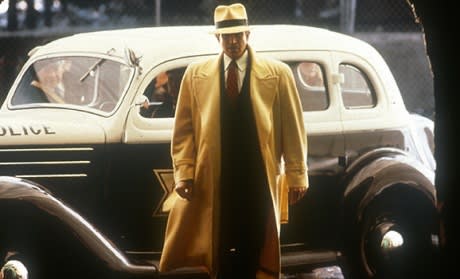At the time of its release, Dick Tracy was a huge summer blockbuster complete with fast-food tie-ins and insipid PR stories on Entertainment Tonight. Buzz about on-set romance between Warren Beatty and Madonna kept the tabloids preoccupied, as did a campaign that found the many dramatically made-up mobsters featured on their own posters around major metropolitan areas.
And while the neo-noir pop art, comic hybrid had the aesthetic down pat, using exaggerated primary colours in a storyboarded, comic book world with moody lighting and shadows, the story itself suffered a few hiccups.
The basic premise of the origin story was there, with Tracy (Beatty) battling Big Boy Caprice (Al Pacino) and his newly organize crime syndicate. When not foiling gambling operations and extortion incidents, he's tiptoeing around the marriage idea with Tess Trueheart (Glenne Headly) and playing an ersatz father to a sneaky and industrious street kid (Charlie Korsmo).
But rather than focus on an intricate mystery or the murky thematic grey area between a hothead detective and a hierarchy of organized criminals, developing a democracy-adjacent, exploitive dictatorship presence with traditional Judeo-Christian vengeance and punishment, Beatty's rendition of this franchise focuses on issues of the heart.
Caught between the progressive safety of a healthy, loving marriage to Tess and a new flirtation with lounge singer Breathless Mahoney (Madonna)—a woman trapped in the middle of the gangland feuds—Tracy struggles with the notion of manhood. Should he settle down with a wife, a child and a cushy desk job, or should he continue fighting crime and bedding morally ambiguous dames—surely a character arc that Beatty himself could identify with at the time.
Resultantly, the film features an abundance of unnecessary close-ups and musical montages featuring Madonna and completely glosses over the many interchangeable mobster characters that serve little purpose to the story. Effort is made to give screen time to the many different characters from the comics, but without any context or purpose in their presence, it all comes across as messy and confusing pulp.
Even the big arrest scenes and central conflict between Tracy and Caprice is limited to a brief, quickly edited montage that's more interested in Madonna's curves than anything pertaining to the noir genre or crime world ethos.
Still, Dick Tracy constructed a very specific, visually compelling universe for these many characters to inhabit, making it a visual treat even to this day, even if it's little more than cheesy pap.
Dick Tracy screens at the TIFF Bell Lightbox as part of the Comic Book Heroes retrospective at 1pm on March 11th, 2013.
(Touchstone/Buena Vista)And while the neo-noir pop art, comic hybrid had the aesthetic down pat, using exaggerated primary colours in a storyboarded, comic book world with moody lighting and shadows, the story itself suffered a few hiccups.
The basic premise of the origin story was there, with Tracy (Beatty) battling Big Boy Caprice (Al Pacino) and his newly organize crime syndicate. When not foiling gambling operations and extortion incidents, he's tiptoeing around the marriage idea with Tess Trueheart (Glenne Headly) and playing an ersatz father to a sneaky and industrious street kid (Charlie Korsmo).
But rather than focus on an intricate mystery or the murky thematic grey area between a hothead detective and a hierarchy of organized criminals, developing a democracy-adjacent, exploitive dictatorship presence with traditional Judeo-Christian vengeance and punishment, Beatty's rendition of this franchise focuses on issues of the heart.
Caught between the progressive safety of a healthy, loving marriage to Tess and a new flirtation with lounge singer Breathless Mahoney (Madonna)—a woman trapped in the middle of the gangland feuds—Tracy struggles with the notion of manhood. Should he settle down with a wife, a child and a cushy desk job, or should he continue fighting crime and bedding morally ambiguous dames—surely a character arc that Beatty himself could identify with at the time.
Resultantly, the film features an abundance of unnecessary close-ups and musical montages featuring Madonna and completely glosses over the many interchangeable mobster characters that serve little purpose to the story. Effort is made to give screen time to the many different characters from the comics, but without any context or purpose in their presence, it all comes across as messy and confusing pulp.
Even the big arrest scenes and central conflict between Tracy and Caprice is limited to a brief, quickly edited montage that's more interested in Madonna's curves than anything pertaining to the noir genre or crime world ethos.
Still, Dick Tracy constructed a very specific, visually compelling universe for these many characters to inhabit, making it a visual treat even to this day, even if it's little more than cheesy pap.
Dick Tracy screens at the TIFF Bell Lightbox as part of the Comic Book Heroes retrospective at 1pm on March 11th, 2013.
